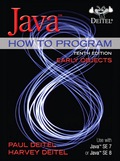
Java How To Program (Early Objects)
10th Edition
ISBN: 9780133807943
Author: Deitel, Paul
Publisher: Pearson Education
expand_more
expand_more
format_list_bulleted
Textbook Question
Chapter 1, Problem 1.1SRE
Computers process data under the control of sets of instructions called
Expert Solution & Answer
Program Description Answer
Computer programs are used by computers for processing data under the control of set of instructions.
Hence, the correct answer is “Computer programs”.
Explanation of Solution
Computer programs
- A computer program is a collection of instructions that performs a specific task when executed by a computer.
- Most computer devices require programs to function properly.
- A computer program is usually written by a computer programmer in a programming language.
- A compiler or assembler can derive machine code from the program in its human-readable form of source code
- Alternatively, a computer program may be executed with the aid of an interpreter.
- Computer programs may be categorized along functional lines, such as application software and system software.
Want to see more full solutions like this?
Subscribe now to access step-by-step solutions to millions of textbook problems written by subject matter experts!
schedule02:30
Students have asked these similar questions
4. |z + 5 - 5i| = 7
14.
dz,
C: |z❘
C: |z❘ = 0.6
ze² - 2iz
H
14.
dz,
C: |z❘
C: |z❘ = 0.6
ze² - 2iz
H
Chapter 1 Solutions
Java How To Program (Early Objects)
Ch. 1 - Computers process data under the control of sets...Ch. 1 - Prob. 1.2SRECh. 1 - Prob. 1.3SRECh. 1 - The programs that translate high-level language...Ch. 1 - Prob. 1.5SRECh. 1 - software is generally feature complete,...Ch. 1 - Prob. 1.7SRECh. 1 - Prob. 2.1SRECh. 1 - The command from the JDK compiles a Java program.Ch. 1 - A Java source code file must end with thefile...
Ch. 1 - When a Java program is compiled, the file produced...Ch. 1 - The file produced by the Java compiler...Ch. 1 - Prob. 3.1SRECh. 1 - Java programmers concentrate on creating, which...Ch. 1 - Prob. 3.3SRECh. 1 - A new class of objects can be created conveniently...Ch. 1 - is a graphical language that allows people who...Ch. 1 - The size, shape, color and weight of an object are...Ch. 1 - Prob. 1.1ECh. 1 - Prob. 1.2ECh. 1 - Prob. 1.3ECh. 1 - Prob. 1.4ECh. 1 - Prob. 1.5ECh. 1 - Prob. 1.6ECh. 1 - Prob. 1.7ECh. 1 - languages are most convenient to the programmer...Ch. 1 - The only language a computer can directly...Ch. 1 - Prob. 1.10ECh. 1 - Theprogramming language is now used to develop...Ch. 1 - initially became widely known as the development...Ch. 1 - Prob. 2.3ECh. 1 - Theprogramming language was developed by Bjarne...Ch. 1 - Java programs normally go through five...Ch. 1 - Prob. 3.2ECh. 1 - Prob. 3.3ECh. 1 - A(n)is a software application that simulates a...Ch. 1 - Thetakes the .class files containing the programs...Ch. 1 - Prob. 3.6ECh. 1 - Explain the two compilation phases of Java...Ch. 1 - Prob. 5ECh. 1 - Prob. 1MDCh. 1 - Prob. 2MDCh. 1 - (Attributes of Hybrid Vehicles) In this chapter...Ch. 1 - Prob. 4MD
Additional Engineering Textbook Solutions
Find more solutions based on key concepts
Determine the horizontal and vertical components of reaction at the supports. Neglect the thickness of the beam...
INTERNATIONAL EDITION---Engineering Mechanics: Statics, 14th edition (SI unit)
Write the first line of the declaration for a Poodle class. The class should be derived from the Dog class with...
Starting Out with C++ from Control Structures to Objects (9th Edition)
What is the difference between the methods System.out.println and System.out.print?
Java: An Introduction to Problem Solving and Programming (8th Edition)
How Old Would You Be on Mercury? The length of a Mercurian year is 88 Earth days. Write a program that requests...
Introduction To Programming Using Visual Basic (11th Edition)
When a large-diameter hole is to be drilled, why is a smaller-diameter hole often drilled first?
Degarmo's Materials And Processes In Manufacturing
In an object-oriented programming environment, how are types and classes similar? How are they different?
Computer Science: An Overview (13th Edition) (What's New in Computer Science)
Knowledge Booster
Learn more about
Need a deep-dive on the concept behind this application? Look no further. Learn more about this topic, computer-science and related others by exploring similar questions and additional content below.Similar questions
arrow_back_ios
SEE MORE QUESTIONS
arrow_forward_ios
Recommended textbooks for you
 Enhanced Discovering Computers 2017 (Shelly Cashm...Computer ScienceISBN:9781305657458Author:Misty E. Vermaat, Susan L. Sebok, Steven M. Freund, Mark Frydenberg, Jennifer T. CampbellPublisher:Cengage Learning
Enhanced Discovering Computers 2017 (Shelly Cashm...Computer ScienceISBN:9781305657458Author:Misty E. Vermaat, Susan L. Sebok, Steven M. Freund, Mark Frydenberg, Jennifer T. CampbellPublisher:Cengage Learning Principles of Information Systems (MindTap Course...Computer ScienceISBN:9781305971776Author:Ralph Stair, George ReynoldsPublisher:Cengage Learning
Principles of Information Systems (MindTap Course...Computer ScienceISBN:9781305971776Author:Ralph Stair, George ReynoldsPublisher:Cengage Learning C++ for Engineers and ScientistsComputer ScienceISBN:9781133187844Author:Bronson, Gary J.Publisher:Course Technology Ptr
C++ for Engineers and ScientistsComputer ScienceISBN:9781133187844Author:Bronson, Gary J.Publisher:Course Technology Ptr Principles of Information Systems (MindTap Course...Computer ScienceISBN:9781285867168Author:Ralph Stair, George ReynoldsPublisher:Cengage Learning
Principles of Information Systems (MindTap Course...Computer ScienceISBN:9781285867168Author:Ralph Stair, George ReynoldsPublisher:Cengage Learning Systems ArchitectureComputer ScienceISBN:9781305080195Author:Stephen D. BurdPublisher:Cengage Learning
Systems ArchitectureComputer ScienceISBN:9781305080195Author:Stephen D. BurdPublisher:Cengage Learning Fundamentals of Information SystemsComputer ScienceISBN:9781337097536Author:Ralph Stair, George ReynoldsPublisher:Cengage Learning
Fundamentals of Information SystemsComputer ScienceISBN:9781337097536Author:Ralph Stair, George ReynoldsPublisher:Cengage Learning

Enhanced Discovering Computers 2017 (Shelly Cashm...
Computer Science
ISBN:9781305657458
Author:Misty E. Vermaat, Susan L. Sebok, Steven M. Freund, Mark Frydenberg, Jennifer T. Campbell
Publisher:Cengage Learning

Principles of Information Systems (MindTap Course...
Computer Science
ISBN:9781305971776
Author:Ralph Stair, George Reynolds
Publisher:Cengage Learning

C++ for Engineers and Scientists
Computer Science
ISBN:9781133187844
Author:Bronson, Gary J.
Publisher:Course Technology Ptr

Principles of Information Systems (MindTap Course...
Computer Science
ISBN:9781285867168
Author:Ralph Stair, George Reynolds
Publisher:Cengage Learning

Systems Architecture
Computer Science
ISBN:9781305080195
Author:Stephen D. Burd
Publisher:Cengage Learning

Fundamentals of Information Systems
Computer Science
ISBN:9781337097536
Author:Ralph Stair, George Reynolds
Publisher:Cengage Learning
Introduction to Computers; Author: Tutorials Point (India) Ltd.;https://www.youtube.com/watch?v=-AP1nNK3bRs;License: Standard YouTube License, CC-BY
Computers for Beginners: Introduction; Author: Carson City Library;https://www.youtube.com/watch?v=jH8pgGfG9HY;License: Standard Youtube License